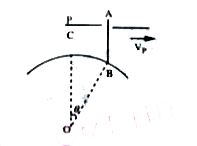Velocity of three particles A, B and C varies with time 't' as VA=(2tˆi+6ˆj)ms−1,¯¯¯VB=(3ˆi+4ˆj)ms−1,¯¯¯Vc=(6ˆi+4tˆi)ms−1 . Regarding the pseudo force match the entries of column - I with entries in column - II
Column-I Column-II A) On A as observed by B P) Along +ve x-direction B) On B as observed by C Q) Along - ve x-direction C) On A as observed by C R) Along +ve y-direction D) On C as observed by A S) Along - ve y-direction T) zeroSolution in Telugu
The correct Answer is:A−T;B−R;C−R;D−Q
Step by step video, text & image solution for Velocity of three particles A, B and C varies with time 't' as V_A = (2t hati +6hatj) ms^(-1), barV_B =(3hati+4hatj)ms^(-1), barVc = (6hati +4thati)ms^(-1) . Regarding the pseudo force match the entries of column - I with entries in column - II {:("Column-I"," Column-II"),(" A) On A as observed by B"," P) Along +ve x-direction"),(" B) On B as observed by C"," Q) Along - ve x-direction"),(" C) On A as observed by C"," R) Along +ve y-direction"),(" D) On C as observed by A"," S) Along - ve y-direction"),(," T) zero"):} by Physics experts to help you in doubts & scoring excellent marks in Class 11 exams.
Updated on:21/07/2023Topper's Solved these Questions
- NEWTONS LAWS OF MOTION BOOK - AAKASH SERIESCHAPTER - NEWTONS LAWS OF MOTION EXERCISE - ADDITIONAL PRACTICE EXERCISE (LEVEL - II (LECTURE SHEET (ADVANCED)) (Integer Type Questions )
3 Videos
- NEWTONS LAWS OF MOTION BOOK - AAKASH SERIESCHAPTER - NEWTONS LAWS OF MOTION EXERCISE - ADDITIONAL PRACTICE EXERCISE PRACTICE SHEET (ADVANECED) (Straight Objective Type Questions)
5 Videos
- NEWTONS LAWS OF MOTION BOOK - AAKASH SERIESCHAPTER - NEWTONS LAWS OF MOTION EXERCISE - ADDITIONAL PRACTICE EXERCISE (LEVEL - II (LECTURE SHEET (ADVANCED)) (Linked Comprehension Type Questions)
2 Videos
- MOTION IN A STRAIGHT LINEBOOK - AAKASH SERIESCHAPTER - MOTION IN A STRAIGHT LINEEXERCISE - Questions for Descriptive Answers
7 Videos
- OSCILLATIONBOOK - AAKASH SERIESCHAPTER - OSCILLATIONEXERCISE - QUESTIONS FOR DESCRIPTIVE ANSWERS
12 Videos
Similar Questions
Two blocks 'A' and 'B' each of mass 'm' are placed on a smooth horizontal surface. Two horizontal force F and 2F are applied on both E the blocks 'A' and 'B' respectively as shown in figure. The block A does not slide on block B. Then the normal reaction acting between the two blocks is xF. The value of

View SolutionA platform P is moving with a velocity vp over hemispherical shell. A vertical rod AB passing through a hole in the platform is moving on the shell and remains vertical. There is sufficient friction between rod and shell to stop the slip. C is the crown of the shell and O is its centre ∠BOC=θ at any instant. Find the velocity of point B in downward motion at that instant.

View SolutionA block of mass 'm' is placed on wedge of mass 'M'. If all the surfaces are smooth

Accelaration of wedge 'A' is
View SolutionThree tortoises are located at the vertices of an equilateral triangle whose side equals a They all start moving simultaneously with velocity v constant in modulus with the first tortoise heading continually for the second , the second for the third and the third for the first . They will meet after time
View SolutionThe spring shown in figure is unstretched when a man starts pulling on the cord. The mass of the block is M. If the man exerts a constant force F, find the amplitude and the time period of the motion of the block.

View SolutionColumn - I and Column - II contains four emtries each. Entries of Column -I are to be matched with some entries of Column - II . One or more than one entries of Column -I may have the matching with the same entries of Column - II.
column-Icolumn-II(A) Coagultation (P) Due to persence of charge (B) Electrophoresis (Q) Due to scattering of light (C) tyndall effect(R) Due to netralization of charge (D)Brownian movement(S) Due to impact of the molecules of the dis-persion medium with colloidal particles
View SolutionMatch the column-I with column-II {:("Column_I","Column-II"),((i) "Equilibrium",(a) DeltaG=+ve),((ii) "Spontaneous reaction",(b) DeltaG=0),((iii) "Non-spontaneous reaction",(c) DeltaG=-ve):}
View SolutionEntries of Column-I are to be matched with entrices of Column-II. Each entry of Column-I may have the matching with one or more than entries of Column-II
View SolutionMatch the entries in column I with entries in Column II and then pick out correct options. Column I Column II
View SolutionEntries of Column-I are to be matched with entrices of Column-II. Each entry of Column-I may have the matching with one or more than entries of Column-II
View SolutionEntries of Column-I are to be matched with entrices of Column-II. Each entry of Column-I may have the matching with one or more than entries of Column-II
View SolutionEntries of Column-I are to be matched with entrices of Column-II. Each entry of Column-I may have the matching with one or more than entries of Column-II
View SolutionEntries of Column-I are to be matched with entrices of Column-II. Each entry of Column-I may have the matching with one or more than entries of Column-II
View SolutionEntries of Column-I are to be matched with entrices of Column-II. Each entry of Column-I may have the matching with one or more than entries of Column-II
View SolutionEntries of Column-I are to be matched with entrices of Column-II. Each entry of Column-I may have the matching with one or more than entries of Column-II
View Solution
